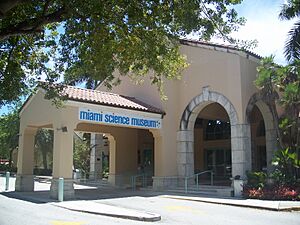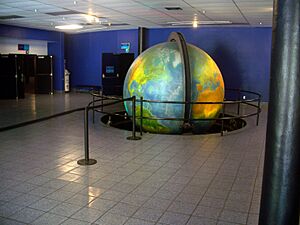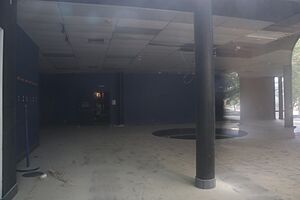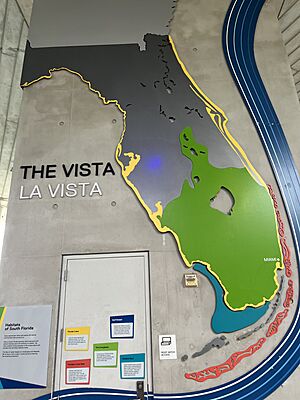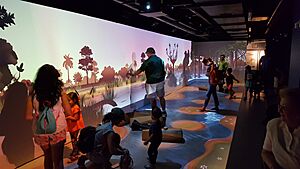Phillip and Patricia Frost Museum of Science facts for kids
 |
|
| Lua error in Module:Location_map at line 420: attempt to index field 'wikibase' (a nil value). | |
| Former name | Miami Science Museum and Space Transit Planetarium |
|---|---|
| Established | 1949 (as the Junior Museum of Miami) |
| Location | Maurice A. Ferré Park, Miami, Florida, U.S. |
| Type | Science museum |
| Accreditation | AAM, ASTC |
| Visitors | Estimated 700,000 per year |
| Public transit access | Metrorail access at Museum Park Station (formerly Vizcaya station) |
The Phillip and Patricia Frost Museum of Science is a cool place in Miami, Florida. It's a science museum, a planetarium, and an aquarium all in one! It used to be called the Miami Science Museum. The museum first opened in 1960 in a different spot called Coconut Grove. In 2017, it moved to a new, modern building in downtown Miami's Maurice A. Ferré Park.
Contents
Museum History
Early Beginnings
The museum started way back in 1950. It was first known as the Junior Museum of Miami. It was run by a group of women volunteers called the Junior League of Miami. They started it in a house with very little money. The exhibits were mostly things people donated. For example, there was a real honeybees hive hanging outside a window! They also borrowed items, like old Seminole artifacts.
In 1952, the museum moved to a bigger building. It was then renamed the Museum of Science and Natural History. More volunteers joined in 1953 to help with tours and programs.
New Buildings and Planetarium
In 1960, Dade County built a new museum building. It was about 48,000 square feet big. This building was in Coconut Grove, near the Vizcaya Museum and Gardens.
A special part was added in 1966: the Space Transit Planetarium. It had a unique projector that showed the stars. This projector was one of only 12 ever made! It was still working when the museum closed its old location in 2015. The Planetarium was also where the national TV show Star Gazers was filmed.
In 2011, the museum started hosting the Miami Underwater Festival. This event celebrated underwater photography and images.
The old museum location in Coconut Grove closed in 2015. The special planetarium projector was moved to the HistoryMiami museum. There, you can still see it on display.
Moving to a New Home
In 2011, a Miami native named Phillip Frost and his wife, Patricia, gave $35 million. This money helped build a brand new science museum in Downtown Miami. The new museum was designed by famous architects.
The new Phillip and Patricia Frost Museum of Science opened on May 8, 2017. It cost $305 million to build. The museum is huge, about 250,000 square feet. It sits on 4 acres of land in Museum Park. The complex has four buildings that are connected. It even has parking underneath!
The new museum is also very eco-friendly. It has a special "LEED Gold" certification. This means it was built using green methods.
- The Frost Planetarium has 250 seats. It has a giant dome screen that is 67 feet wide. It uses 16 million colors and a super clear 8K projection system.
- The Aquarium is shaped like a cone and is three stories tall. It holds 500,000 gallons of water! You can see fish, rays, and sharks. There's even a 31-foot wide window at the bottom to look up at the animals.
- The North and West Wings have many different galleries. Some exhibits are always there, and others change. These wings also have a gift shop, offices, and classrooms.
As of June 2023, the old museum site in Coconut Grove was taken down. This made space for a new project called Vizcaya Village.
Exciting Exhibits
The Aquarium
The museum's aquarium has many levels. It shows off the different water habitats found in South Florida. The top level has a huge 500,000-gallon Gulf Stream Aquarium. Here you can see amazing creatures like mahi-mahi, devil rays, and hammerhead sharks.
The middle level shows places like coral reefs and mangrove forests. There are almost 30 smaller aquariums. These show how many different kinds of plants and animals live in these warm water areas. The lowest level lets you look up into the Gulf Stream Aquarium. You can see jellyfish floating in the strong ocean current. This level ends with a huge 31-foot round window. It forms the bottom of the Gulf Stream Aquarium.
The Planetarium
The Frost Planetarium is a fantastic place to explore space. It has 250 seats and a huge 67-foot wide dome screen. Six powerful projectors create amazing images with 16 million colors. The sound system is also incredible. The planetarium also hosts fun laser shows. These shows feature laser graphics set to music from bands like Pink Floyd and Queen.
Power of Science
The Power of Science exhibit celebrates what scientists have discovered. It also looks at what science might do in the future. This exhibit has many hands-on activities. You can see rare items and learn about the periodic table of elements. There's even an interactive floor! You'll learn about the scientific process. The exhibit focuses on four main areas: the ocean, the environment, the human body, and the universe.
Solar System and Beyond
This exhibit shows more than 20 photos and drawings of space objects. These amazing images were created by NASA.
Feathers to the Stars
Feathers to the Stars tells the story of flight. It starts with animals that fly using wings. Then it moves to how humans created airplanes and spacecraft. You can see how things like lift, drag, and thrust work. There's even a small wind tunnel for demonstrations. The exhibit also has a display of cool NASA items and tools.
meLab
The meLab is an interactive exhibit about health and staying well. It teaches you why making good choices is important for your future. This exhibit is on two levels. On Level 2, you can play games that help you learn about healthy living. On Level 3, you can explore what health means at a tiny, microscopic level.
River of Grass
The River of Grass is a fun, interactive exhibit about the Everglades. It's especially great for kids! It has an outdoor area where you can touch things. Inside, there's a virtual Everglades. Animal characters talk to you and teach you about biodiversity through stories.
The Sun Spot
This exhibit teaches you all about solar power and the sun. It has six different displays. These show how solar power can be used in different ways. You can find this exhibit on the roof of the museum.
Temporary Displays
The museum has a large area near the entrance. This space is used for special temporary exhibits and events that change throughout the year.
See also
- List of planetariums
- Star Gazers


